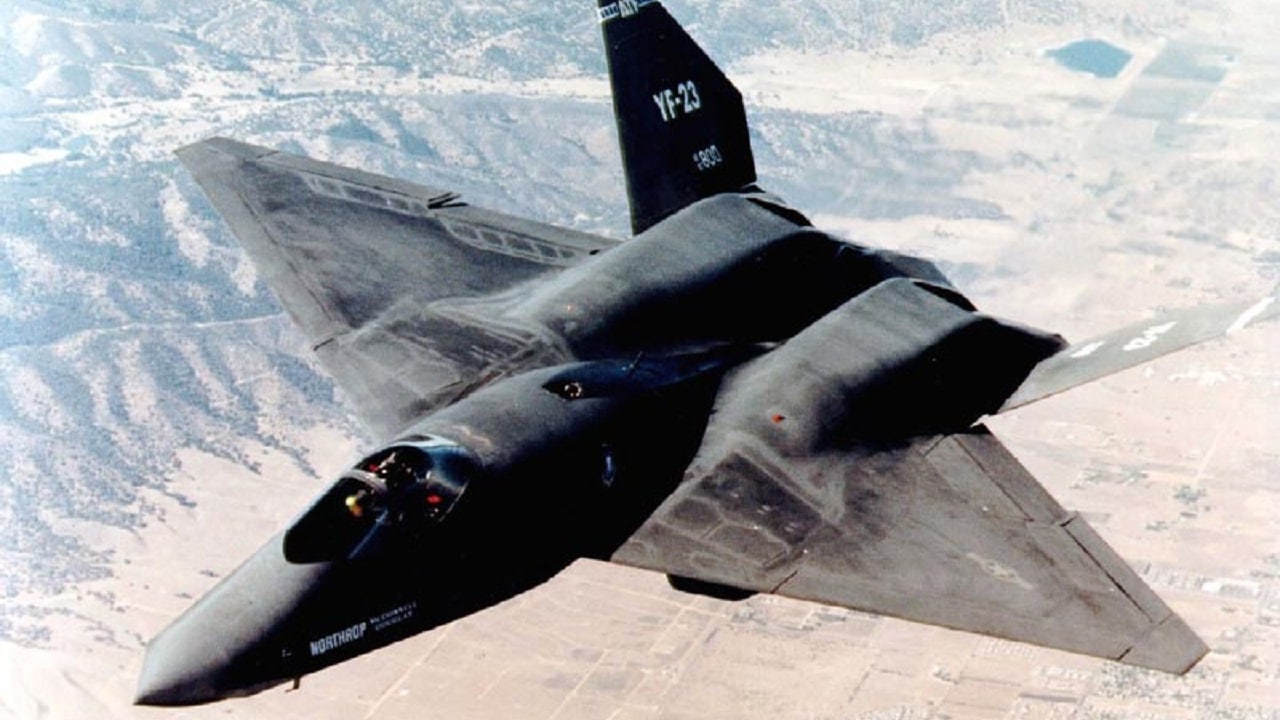The Northrup McDonnell-Douglas YF-23 Advanced Tactical Fighter (ATF) is almost forgotten by many, thanks to the F-22 Raptor and how dominant it is. This other prototype design participated in the 1991 fly-off between the two competing designs.
The loser, some would say regrettably – of the “demonstration/validation competition” between this aircraft and the Lockheed-Boeing-General Dynamics YF-22 design.
The “winner” of the competition was given the contract to proceed to full-scale development and production.
This process would turn one of the “YF” aircraft into “F” models, or fully-developed testbeds that would be flown to validate the final validated design before the plane proceeded on to series production.
With the increasing discussion today about the current NGAD program, the YF-23, which slipped into semi-oblivion and was almost forgotten about, has seen a resurgence in interest in its design.
Some claim that aspects of its design have been forgotten, but today’s designers of modern fighter would do well to take a second look at.
YF-23: Could It Beat the F-22?
One of the main differences between the two prototypes was that overall, the “YF-23 was faster and stealthier, but the YF-22 was rated as being more agile.”
The YF-23 also “showcased better range, higher ceiling, and superior stealth features,” reads another history of the fly-off. “However, during flight demonstrations, the YF-22 excelled by performing more aggressive maneuvers and missile launches.”
It was the YF-22 being more of a “fighter pilot’s airplane” is what impressed the USAF, said one long-time US observer of the various stealth fighter programs over the years.
“The objective of the ATF program was to have a fighter that was going to be stealthy enough to remain unseen by enemy fighter radars and air defense systems and then to be able to turn and run away fast enough to survive,” he said.
“What no one wants to admit is the ‘white-scarf, inside the furball’ fighter mafia still reigned supreme in that time, an observation echoed by test pilot Paul Metz, one of the few to ever fly both aircraft.
“Northrop’s YF-23 team was made up of brilliant engineers,” as he recalled, and Metz describes them as beyond compare, but he also saw that they “thought and spoke almost exclusively in engineering terms.”
Meanwhile, he continued, “Lockheed infused far more marketing, salesmanship, and pizazz—’lasting impressions’ as he describes”—into their YF-22 flight demonstration program. “They fundamentally understood how to sell their aircraft and how ‘showmanship’ heavily impacts the acquisition decision-making process. Northrop didn’t and that fact may have proven fatal for the YF-23.”
Why Requirements Matter
More than 30 years back is a long time ago, so saying today that the YF-23 is a better fit for the air combat environment in 2025 is more than a bit of hindsight.
However, one of the well-known writers about stealth designs in the aviation community is James Stevenson, the author of an exhaustive book on the ill-fated A-12 stealthy carrier attack aircraft. He spoke to 19FortyFive about some unknown details of the actual fly-off.
“The purpose of the fly-off that selected the YF-22 was supposed to validate which design most comprehensibly met all the major requirements. These were stealth, an AESA radar and the ability to supercruise,” he stated.
“But the YF-22 demonstrated none of these. Neither the stealth characteristics nor the radar were prepared enough for demonstration. Of the two aircraft, only YF-23 ever supercruised and that was the prototype with the GE F-120 engine – the engine that lost in the competition to the Pratt & Whitney F119 – even though it demonstrated better performance.
The USAF in essence, selected an empty prototype – an “aerodynamic paint job,” as Stevenson puts it – “and then said to the contractors ‘now go develop the aircraft’”.
No one would say that the F-22 is not an impressive-performing aircraft. Pilots who have flown it say that they “like the situation of not being able to be seen on radar and that it is a marvellous machine.”
But the aircraft is set to begin its sunset years in 2030, while aircraft designed more than 30 years earlier, like the F-15 continue in production and are still in considerable demand.
Had the YF-23 been the winner, it might be an even greater asset to the U.S. Air Force.
But looking back, as one former fighter pilot friend reminds me, “does not do you any good in this business.”
THOSE 4 Words: YF-23 Never Had a Chance
About the Author: Reuben F. Johnson
Reuben F. Johnson is a survivor of the February 2022 Russian invasion of Ukraine and is now an Expert on Foreign Military Affairs with the Fundacja im. Kazimierza Pułaskiego in Warsaw. He has been a consultant to the Pentagon, several NATO governments and the Australian government in the fields of defense technology and weapon systems design. Over the past 30 years he has resided in and reported from Russia, Ukraine, Poland, Brazil, the People’s Republic of China and Australia.

